Location, Location, Location: The Road to Ultra-Wideband
January 4, 2021

Although it’s been around for some time now, Ultra-wideband (UWB) is considered the new “location technology” kid on the block, and it’s growing at a healthy pace. Its precision-accurate capabilities are what sets it apart from other location solutions, and it’s a key enabler to exciting – and vital – new use cases.
Location technology has traveled a long road to get to where we are with UWB, but how did we get here? To fully understand, it’s helpful to look at how it originated, the role it plays, how it works, and the use cases it powers. In this post, we look at the history of location technology and explore the solutions that led to the pin-point, real-time accuracy of UWB.
A Look Back at Location Technology
Stars, Maps and Compasses
Location technology stems back to the beginning of time. Celestial navigation has long been used for direction-finding, wayfinding, steering and piloting through position fixing. Then came the magnetic compass in the early 11th century. And, of course, paper maps, asking for directions, and trial and error helped people to find their way around the world.
Satellites Lead the Way
Leaping ahead to the late 1990s and early 2000, Global Positioning Systems (GPS) found their way into the mainstream. GPS was a huge advance in location technology and gave way to a new level of convenience that changed our lives in many ways. It allowed users to electronically locate the nearest gas station, track fitness, map out travel plans, and find their way home. For businesses, the benefits go way beyond convenience – it is a matter of efficiency or even a matter of building sustainable business models. Without GPS, how would companies like Amazon, FedEx and UPS efficiently navigate deliveries to your doorstep?
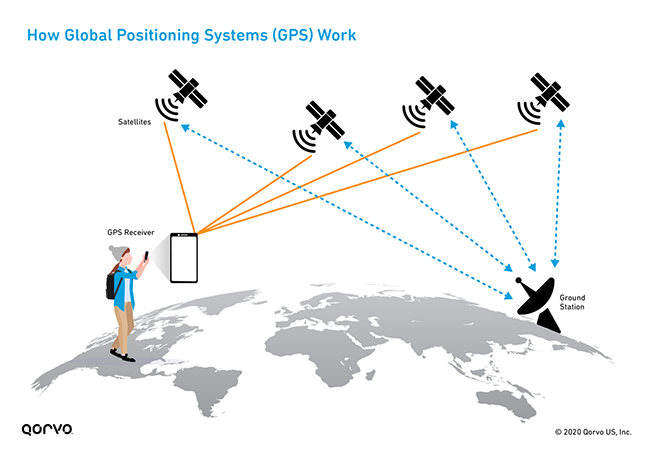 When most people think about location technology, they think of a Global Positioning System (GPS), which is the premier technology for outdoor navigation. GPS works using satellites that transmit unique signals and orbital parameters to ground stations and receivers – such as a mobile phone. The receiver, using signals from 4 or more satellites, decodes and then calculates the distance to find its exact location.
When most people think about location technology, they think of a Global Positioning System (GPS), which is the premier technology for outdoor navigation. GPS works using satellites that transmit unique signals and orbital parameters to ground stations and receivers – such as a mobile phone. The receiver, using signals from 4 or more satellites, decodes and then calculates the distance to find its exact location.
Navigation Goes Inside
Ten years later, we saw another breakthrough that brought navigation inside, aptly called indoor navigation or positioning – think Google Maps for malls, airports, and other large buildings. Indoor positioning is, in many ways, an inside version of the satellite-navigation apps we rely on for outdoor navigation, but with an added twist – it can also be used to help locate people and things. Much like GPS, indoor navigation uses positioning systems made up of sensors and communication technologies – Wi-Fi, Bluetooth® Low Energy (LE), Zigbee and Thread enabled devices – to locate objects in indoor environments.
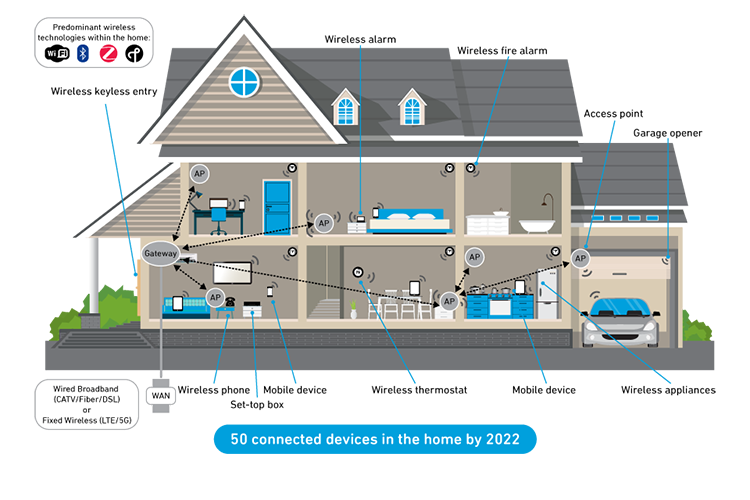 Wireless Indoor Architecture with a Pod in Every Room using communications technologies such as Wi-Fi, Bluetooth® Low Energy (LE), Zigbee and Thread.
Wireless Indoor Architecture with a Pod in Every Room using communications technologies such as Wi-Fi, Bluetooth® Low Energy (LE), Zigbee and Thread.
The Path to Small
Fast forward to today and we’re now seeing the rise of micro location-based systems. People and businesses want to be able to locate and find pretty much anything in real time, whatever its size. Let’s say you’re at home and misplaced your car keys, or you’re in a grocery store and can’t find your favorite brand of coffee. Or maybe you’re working in a factory and need a particular tool from a storage bin, or you’re a site manager dealing with an emergency and need to make sure everyone’s exited the building. Indoor positioning at the micro level helps in all these situations because it can locate items and guide you to where they are.
To offer enough accuracy, reliability and real-time capability, the underlying technology needs to be designed for precise location. This is where UWB technology is changing the game by delivering highly valuable location information across many different applications.
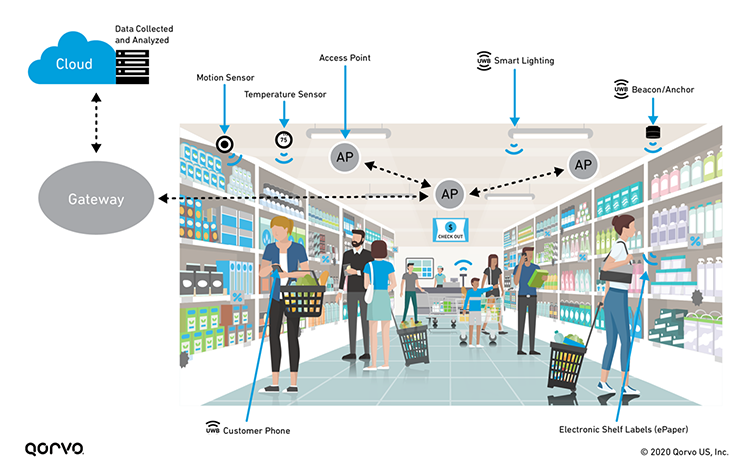 The adoption of Ultra-wideband (UWB) in flagship smartphones opens up the possibilities for much more precise, reliable indoor positioning and navigation than would be possible with BLE alone. Its extremely precise locating abilities can locate products and people within one centimeter.
The adoption of Ultra-wideband (UWB) in flagship smartphones opens up the possibilities for much more precise, reliable indoor positioning and navigation than would be possible with BLE alone. Its extremely precise locating abilities can locate products and people within one centimeter.
Plotting the Micro-level Requirements
Developing an effective technology for indoor positioning at the micro-level requires several things. To begin with, location readings need to be very precise with accuracy down to as small an area as possible. The technology has to be secure, because the location often needs to be kept private. It also needs to be reliable, even in harsh environments, and easily scalable too, so it can address the thousands of people and assets in large venues. Other requirements include low power and affordability so it can be embedded in everything from high-end, complex devices like smartphones to low-end, simple devices like asset tags. And, of course, the technology has to have latency low enough that it can track movement in real-time.
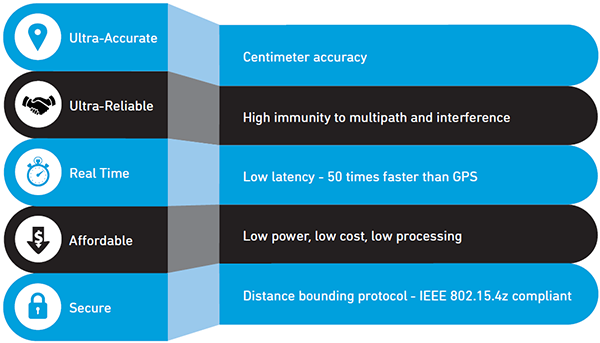 Requirements for Micro-based Indoor Positioning
Requirements for Micro-based Indoor Positioning
When designing the first indoor location systems, engineers used the technologies that were available to them – usually Wi-Fi and Bluetooth Low Energy (BLE). While those technologies are great for data communication – what they were invented for – none of them were designed for real-time location services (RTLS), and therefore, don’t meet all micro-based indoor positioning requirements.
Wi-Fi, Bluetooth, and other narrowband radio systems can only reach an accuracy of several meters. Their reliability doesn’t meet the 99.9% that’s required to build safe and trusted systems. Thousands of devices cannot all report their position simultaneously due to collisions and interference, and they struggle when used in the context of real time location services. Take BLE for example – while best in class for low power data communications, the number of measures and post processing required to get one “okay” location point can drive power consumption through the roof and latency up to seconds.
This is why back in the mid-2000s engineers from the IEEE started to specify a different kind of wireless technology specifically designed for accurate location that would check all the boxes. This technology was named Ultra-wideband (UWB) and has the potential to change the way we do all kinds of everyday tasks.
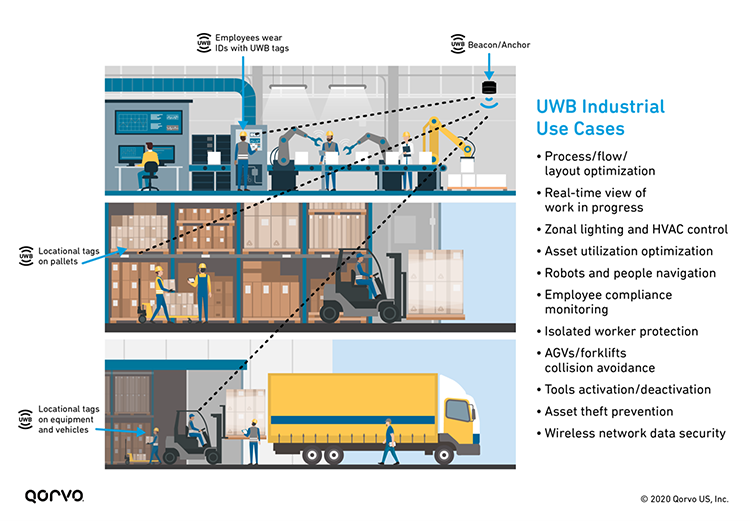 The use of UWB-enabled sensors, tags and smart devices that identify and locate people and things, combined with other hardware and software platforms, allow companies and organizations to conduct a multitude of real-time location services. These include applications from monitoring employee safety to asset location and process/flow optimization, which result in improved efficiencies, better compliance, and cost savings.
The use of UWB-enabled sensors, tags and smart devices that identify and locate people and things, combined with other hardware and software platforms, allow companies and organizations to conduct a multitude of real-time location services. These include applications from monitoring employee safety to asset location and process/flow optimization, which result in improved efficiencies, better compliance, and cost savings.
UWB: Where We are Today
UWB is based on the IEEE standard 802.15.4a/z, which has been optimized for micro-location and secure communication. UWB can pinpoint people and things to within just a few centimeters, making it 100 times more accurate than the current implementations of Bluetooth Low Energy (BLE) and Wi-Fi.
Here’s a synopsis of what makes UWB ideal for RTLS:
- UWB is reliable because it has high immunity to various types of interference, including multipath (when a wave from a transmitter traveling to a receiver by two or more paths causes interference).
- Offers very low latency. Update rates of up to 1000 times per second and readings that are as much as 50 times faster than satellite navigation enable the real-time location/tracking of any object/person.
- Implemented using mainstream CMOS technology, so it’s both affordable and optimized for low power.
- In addition to its location capabilities, UWB offers high data rate and energy efficient data communication – up to 27 mbps today, potentially higher in future revisions of the standard.
- Leverages distance-bounding techniques defined by the IEEE to provide a level of security that makes it an extremely secure format.
Expand Your UWB Knowledge
Connectivity Q&A: The Mesh Network and the Advancement of IoT Devices
How is all this possible? Simply put: physics. UWB is more conducive for micro-location applications because it transmits wideband signals (500 MHz) and uses Time-of-Flight to determine location.
Why UWB is Best When Precise Location Matters Most
Figure 1 below compares narrowband and Ultra-wideband. The UWB pulse (center & right image) is only 2 nano seconds (ns) wide. This makes it immune to reflected signal (multipath) interference. As shown in the center and right images, the reflected signal (red) does not affect the direct signal (blue). These UWB signals also have much faster rise and fall edges than the narrowband signals (left). UWB signals maintain their integrity and structure even in the presence of noise and multi-path effects. Moreover, the UWB clean signal edges, allow precise determination of arrival time and distance.
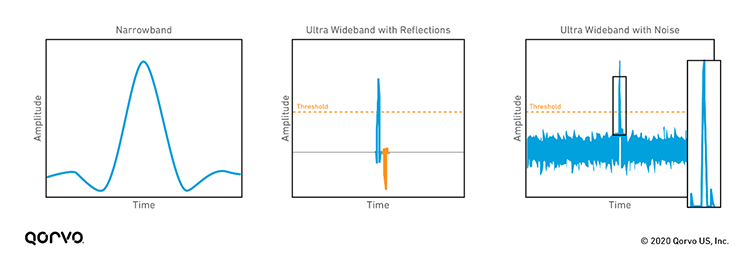 Figure 1: Comparing narrowband signal, Impulse Radio with direct (blue) and reflected signal (orange).
Figure 1: Comparing narrowband signal, Impulse Radio with direct (blue) and reflected signal (orange).
Looking Beyond the Horizon
UWB is already bringing value to products and services in more than forty verticals covering the consumer, automotive, industrial, and commercial market segments – from driving operational efficiencies in factories and warehouses, improving workers’ safety, powering robots and drone self-navigation, to enabling new forms of user interfaces for consumers based on location. It also enables secure, hands-free access to cars, front doors, homes and offices thanks to its secure distance bounding capability.
UWB has proven to be the only technology able to really help with contact tracing and social distancing in the fight against COVID-19 as accuracy and reliability are key attributes to designing effective solutions where you need to trust the data.
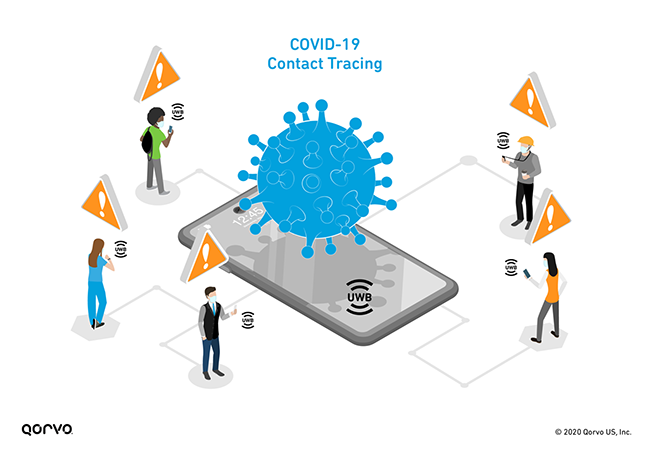 Unlike other wireless technologies, UWB provides the accuracy that's needed for COVID-19 contact-tracing and social distancing. It can calculate the distance between people with centimeter precision, allowing absolute certainty whether someone was close enough to others to transmit the virus.
Unlike other wireless technologies, UWB provides the accuracy that's needed for COVID-19 contact-tracing and social distancing. It can calculate the distance between people with centimeter precision, allowing absolute certainty whether someone was close enough to others to transmit the virus.
With the recent adoption in smartphones, UWB is now on the path to become the next ubiquitous wireless connectivity in our everyday lives – from our homes to our office to public venues. Having UWB in smartphones is an important first step towards mass adoption. But another key ingredient is to guarantee the interoperability between all those devices. The fast-growing consortium FiRa, which already regroups more than 50 companies from the semiconductor, mobile, infrastructure and consumer space, is working actively on the definition of protocols that will guarantee such interoperability. This will make it possible for developers to use UWB in all kinds of new ways – such as indoor mapping and navigation, smart home applications, vehicle access and control, augmented reality, as well as mobile payments. Ultimately, the future of indoor location is really only limited by the developer’s imagination.
Learn more about UWB technology at Qorvo.
The Bluetooth® word mark and logos are registered trademarks owned by Bluetooth SIG, Inc. and any use of such marks by Qorvo US, Inc. is under license. Other trademarks and trade names are those of their respective owners.
Have another topic that you would like Qorvo experts to cover? Email your suggestions to the Qorvo Blog team and it could be featured in an upcoming post. Please include your contact information in the body of the email.
